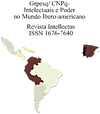Visual dialogues with the "invisible" in the city “Cidade de Goiás”: reinterpretations of colonial landscape and “vilaboense” traditions by the pictorial work of Goiandira do Couto
Keywords:
Colonial Landscape, Reassembly, Tradition, Goiandira do CoutoAbstract
The houses and icons that compose the visible image on Largo do Rosário, by the artist Goiandira do Couto, a 1976 artwork, unveil a panoramic urban view of the “Cidade de Goiás”, through one of its most prestigious streets since the eighteenth century. This article deals with a historical and visual reassembly, which focuses on the comparison between images which expose the visible and the "invisible" in this local sociability space and, likewise, entitle the painting under study. From the works of the landscape genre, which was the aesthetic option of this artist, begins a second artistic phase in which excels the use of colored sand collage technique and water-based glue. We suggest that her belonging to the local elite groups is the supposed justification for the pictorial options Goiandira do Couto, since her subjectivities by the 'invisible' silence about the presence of urban identities of this colonial metropolis.
Downloads
Downloads
Published
How to Cite
Issue
Section
License
Autores que publicam nesta revista concordam com os seguintes termos:
Os autores mantêm os direitos autorais e concedem à revista Intellèctus o direito de publicação, sob uma Licença Creative Commons Atribuição 4.0 Internacional, a qual permite que outros distribuam, remixem, adaptem e criem a partir do seu trabalho, mesmo para fins comerciais, desde que lhe atribuam o devido crédito pela criação original.
Os dados e conceitos abordados são da exclusiva responsabilidade do autor.
A revista Intellèctus está licenciada com uma licença Creative Commons Atribuição 4.0 Internacional





